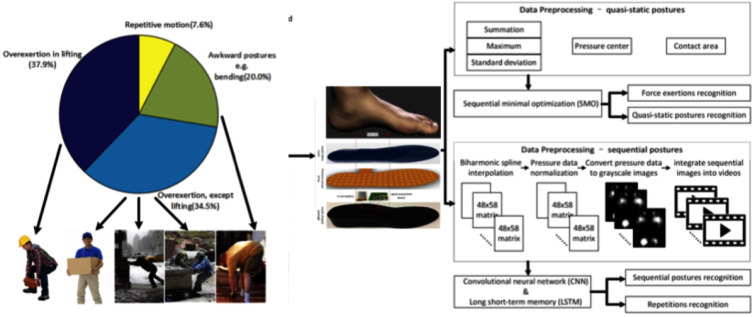Intelligent Assistant for Infrastructure Inspection Worker Health and Safety (Collaborator: Dr. Xiong Yu from CWRU Civil Engineering)
Intelligent assistant design powered by AI will be viable through close integration of advanced technology with human to support the data-driven infrastructure-related decision-making process. Integration of advanced assistant technology will help improve the inspection worker’s efficiency, health welfare, and safety. In this study, we developed a smartphone and wearable solution to identify and visualize work-related injuries, such as slip, trip, and fall (STF), and musculoskeletal disorders (WMSD) risk factors such as awkward postures, force exertions, and excessive repetitions through data-driven approaches, which enable objective worker risk factors identification in their daily routine.
Falls are leading causes of nonfatal injuries in workplaces which lead to substantial injury and economic consequences. In this study, a novel fall hazard identification method is proposed which makes it possible for all workers to report the potential hazards automatically. This method is based on the fact that people use different gaits to get across different floor surfaces. Through analyzing gait patterns, potential fall hazards could be identified automatically. Slips and trips are the focus of this study since they are two main causes of falls in workplaces. Five effective gait features were extracted to train a machine-learning model for recognizing slip hazard, trip hazard, and safe floor surfaces.
Worker Risk factors, such as overexertion, awkward postures, excessive repetition, and the combination of these factors are the main causes of work-related musculoskeletal disorders (WMSDs) which are reported to be the leading nonfatal occupational injuries. However, it is difficult for commonly used risk factors identification methods (e.g. observational methods) to give an objective and comprehensive analysis of these risk factors. To address the above problem, we proposed an automatic WMSDs risk factors identification method using mHealth and wearable technologies.
This research was funded by National Science Foundation Grant (2026612): Distributed Intelligent Assistant to Infrastructure Inspection Workers and Ohio Occupational Safety and Health Research Grant: Prevent Work-related Injuries in Construction Industry, Wholesale, and Retail Trades Workspaces using Wearable Computer Technology.
Publications: [J41, J26, J20]



